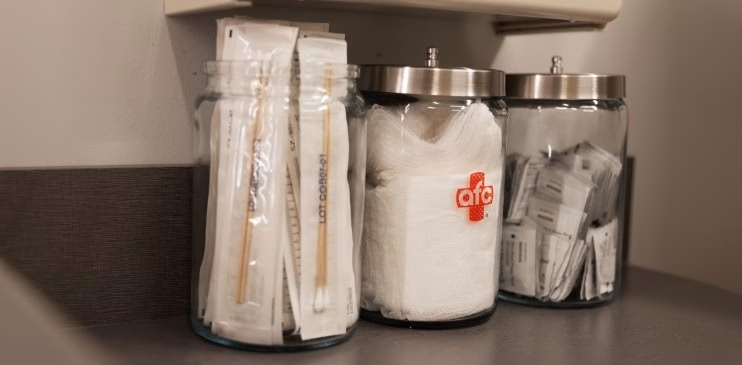We will be closing on Wednesday, 12/24 at 5pm and are closed Christmas Day.
Walk-in or Reserve Your Time Online.
AFC West University
Stitches
CALL US TODAY | (713) 666-7050
Find The Location Nearest Covid-19 Testing
We think you’re located in zip code 77005. Not Right?
Everything You Need to Know About Stitches: Healing Stages, Dissolving, and Removal

If you've ever had stitches, you know they play a crucial role in helping your body heal after a severe cut, injury, or surgery. Stitches can be placed at our AFC Urgent Care Houston clinics, to ensure proper wound closure and healing. But whether it’s a minor cut or a more serious procedure, you might be wondering what stitches do, how long they take to heal, and when they should be removed.
Don't worry! Here’s everything you need to know about stitches, the healing process, and what to do along the way. And if you ever need expert wound care or stitches, visit AFC Urgent Care Texas—we’re here to help!
What Are Stitches (Sutures)?
In simple terms, stitches (or sutures) are medical threads used to close a wound. They hold the skin together while the tissue underneath heals. Depending on the type of injury, stitches need to be removed later after the skin heals or if placed either internally or in specific places, like inside the mouth, can dissolve.
Types of Stitches
- Dissolvable/ Absorbable Sutures: As the name suggests, these stitches are designed to break down and dissolve naturally in your body over time. They're used for internal wounds or in spots that have mucous membranes (think of the inside of your mouth). There is no need for removal—your body does all the work. These stitches are often made of materials such as polyglycolic acid or polyglactin.
- Non-Dissolvable/Non-Absorbable Sutures: These stitches don't dissolve on their own; you will need to see your medical provider or another healthcare provider to remove them once your wound heals. Depending on how your wound is healing, your medical provider will likely take them out after 7 to 14 days after they were placed. Common material types for these stitches include nylon and polypropylene.
How Do Wounds Heal with Stitches?
The healing process for a wound with stitches typically happens in stages, and the timeline can vary based on the severity of the injury and how well you take care of it. Here's a quick rundown of what happens as your body heals with stitches:
- Inflammatory Phase (Days 1–3): After the wound is stitched up, your body stops bleeding and fights off infection. At this stage, it's normal to experience redness, swelling, and pain.
- Proliferation Phase (Days 3–14): During this phase, your body starts making new tissue, and the wound begins to close. You'll notice the wound may look a little less red and more like it's healing.
- Maturation Phase (Weeks 2–6): Your body is strengthening the tissue, and the area starts to feel stronger. The wound will be less prone to infection, though it can still be fragile.
- Final Healing (Months to a Year): Even though the wound looks healed, it can still take up to a year to strengthen the skin and tissues. The scar might fade over time.
How Long Does It Take for Stitches to Dissolve?
If you have dissolvable stitches, you're probably wondering how long they'll take to disappear. On average, dissolvable stitches can take anywhere from a few days to several weeks to dissolve. The body absorbs most dissolvable stitches within 1 to 2 weeks, but complete absorption might take a few months. The reason that not all wounds are stitched with absorbable stitches is that the speed at which they are absorbed is based on the tissue that is stitched. For example, stitches on the skin can be absorbed, but it would take months to a year for that to happen, which would cause more problems than it would help.
How to Care for Stitches
Taking care of your stitches is crucial for a smooth healing process. Here's how you can help your body heal and prevent further complications:
- Keep the area clean and dry: Generally, you should wait about 24 hours before bathing the affected area after getting stitches. Allow mild soap and water to run over the affected area. Do not scrub or put any lotions or solutions directly over the stitched wound. After washing, pat the wound dry with a clean towel.
- Avoid stretching the area: If possible, keep the area where the stitches are as still as possible to prevent them from pulling or coming apart. If you notice any separation of the skin at the wound or increased bleeding at the site, let your medical provider know immediately.
- Watch for infection: Signs of infection include increased pain, redness, swelling, warmth, or pus. If you notice any of these, contact your medical provider.
- Follow your medical provider’s instructions: Whether you have dissolvable or non-dissolvable stitches, it's essential to follow your medical provider's care advice and keep any follow-up appointments.
When Do Stitches Need to Be Removed?
Your medical provider will remove non-dissolvable stitches once the wound is sufficiently healed. Typically, this happens 1-2 weeks after the stitches were placed. This can be much longer if you smoke. If you're unsure, always check with your medical provider about when it's time to have the stitches removed. Here's what you can expect during stitch removal:
- Cleaning: Your medical provider will clean the area first.
- Cutting the sutures: They'll carefully cut the sutures close to the knot using sterile scissors or another tool.
- Removing the stitches: The suture material is gently pulled out, and the wound is cleaned again.
- Dressing the wound: Once the stitches are gone, a fresh bandage is applied to protect the area while it continues to heal.
How to Know When to See a Medical Provider
It's pretty common for stitches to heal without any issues, but there are a few red flags that you shouldn't ignore:
- Signs of infection: If your wound looks increasingly red or swollen or if you notice pus, it's time to see your medical provider.
- Unusual pain: If the area starts hurting more than it should, or if the pain lasts longer than expected, consult your medical provider.
- Stitches not dissolving: If you have dissolvable stitches and they don't seem to be breaking down, call your medical provider to make sure everything's on track.
- Difficult stitch removal: If your medical provider has trouble removing your stitches or seems stuck, they'll know what to do, so don't hesitate to contact your healthcare provider.
According to the Cleveland Clinic, some people may be at an increased risk of infection. These include people who:
- Have diabetes.
- Have a history of smoking tobacco products.
- Have excess weight.
- Experience poor nutrition.
- Have a weakened immune system (for example, if those undergoing chemotherapy or taking immune-suppressing medications).
- Had a recent emergency surgery or a long surgical procedure.
Stitches are essential in helping wounds heal, whether they're dissolvable or need to be removed later. Taking proper care of your stitches and understanding the healing stages can make the process go much smoother. Keep the wound clean, follow your medical provider's advice, and don't hesitate to reach out if something feels off. Most importantly, be patient with your body—it's doing all the hard work to get you back on track!
Review: This content has been reviewed by Dr. Nita Singhal, Chief Medical Officer at AFC Urgent Care Texas, to ensure clinical accuracy and reliability.
 How Can We Help?
How Can We Help?
- PATIENT SERVICES
- COVID-19 SERVICES
- TELECARE
- EMPLOYER RESOURCES
- PATIENT RESOURCES
- ABOUT US
Don't wait to get the medical attention you need.
CALL US TODAY | (713) 666-7050